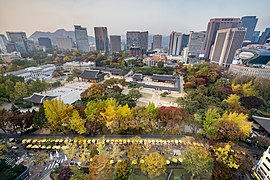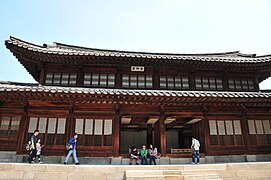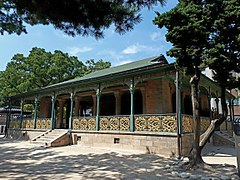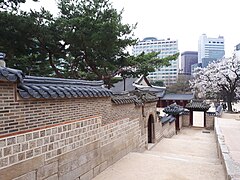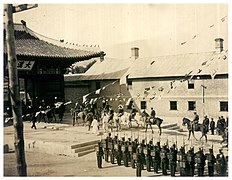| Deoksugung | |
|---|---|
 View of the palace in 2011 | |
|
| |
| General information | |
| Type | Royal palace (former) |
| Town or city | Jung-gu, Seoul |
| Country | South Korea |
| Coordinates | 37°33′58″N 126°58′29″E / 37.56618°N 126.97485°E |
| Website | |
|
www | |
| Deoksugung | |
| Hangul | 덕수궁 |
|---|---|
| Hanja | |
| Revised Romanization | Deoksugung |
| McCune–Reischauer | Tŏksugung |
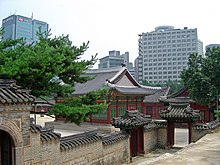

Deoksugung ( Korean: 덕수궁) also known as Gyeongun-gung, Deoksugung Palace, or Deoksu Palace, is a walled compound of palaces in Seoul that was inhabited by members of Korea's royal family during the Joseon monarchy until the annexation of Korea by Japan in 1910. It is one of the " Five Grand Palaces" built by the kings of the Joseon dynasty [1] and designated as a Historic Site. [2] The buildings are of varying styles, including some of natural cryptomeria wood[ citation needed]), painted wood, and stucco. Some buildings were built of stone to replicate western palatial structures.
In addition to the traditional palace buildings, there are also forested gardens, a statue of King Sejong the Great and the National Museum of Art, which holds special exhibitions. The palace is located near City Hall Station.
Deoksugung, like the other " Five Grand Palaces" in Seoul, was heavily damaged during the colonial period of Korea. Currently, only one third of the structures that were standing before the occupation remain. [3]
Deoksugung Palace is special among Korean palaces. It has a modern and a western style garden and fountain. The Changing of the Royal Guard, in front of Daehanmun (Gate), is a very popular event for many visitors. The royal guard was responsible for opening and closing the palace gate during the Joseon dynasty. Outside of the palace is a picturesque road with a stone wall. [4]
The Deoksugung Stonewall walkway is at the heart of a popular urban myth in Seoul, as it is said that all couples who walk down this road are fated to break-up. [5]
History
Deoksugung was originally the residence of Grand Prince Wolsan, the older brother of King Seongjong. This residence became a royal 'palace' during the Imjin war after all of the other palaces were burned in 1592 during the Imjin wars. King Seonjo was the first Joseon king to reside at the palace. King Gwanghaegun was crowned in this palace in 1608, and renamed it Gyeongun-gung (경운궁, 慶運宮) in 1611. After the official palace was moved to the rebuilt Changdeokgung in 1618, it was mostly used as an auxiliary palace was renamed Seogung (West Palace). During its history, it alternated between being a royal residential palace and a temporary residence. [6] [2] Gojong of Joseon ordered the restoration of Gyeongun-gung from August 1896. [7]
In 1897, after the period when Emperor Gojong took refuge in the Russian legation, he returned to this place and named it Gyeongungung again. [8] The Government used 80,000 Dollars for constructing and expanding the facilities of the palace. [9] In 1900, electricity and fencing was installed. After Emperor Gojong abdicated the throne to Emperor Sunjong, he continued to live in this palace. In 1904, a fire destroyed some of the buildings. The palace was then renamed Deoksugung in 1907, as a reference to a wish for longevity of the emperor. Emperor Gojong died in Hamnyeongjeon. [6] [10] [2]
Under Japanese rule after 1910, the palace grounds were operated as a public park, the territory was reduced to one-third and the number of buildings to one-tenth of the original. [11]

Buildings
Daehanmun Gate, originally called Daeanmun before 1906, is the main gate of the current palace.
The main hall, Junghwajeon Hall is where the state affairs, official meetings were held and where the throne is located. It used to be a two-story building but was rebuilt in 1906 with only one story. [10]
Junghwamun Gate is the gate that leads to the main hall. Originally it featured a walled corridor, thus allowing people to only enter the main hall through the gate. The walls were destroyed. [10]
Hamnyengjeon Hall is Emperor Gojong's bedroom, located at the east wing of the palace. This is where the fire broke out in 1904, officially because of the heating system, but it has been suspected that it was done by the Japanese to eliminate Gojong. [10]
Jeonggwanheon is a modern pavilion built in the royal garden in 1900, and was the first Western-style building ever built in a Korean royal palace. Although it was built by a Russian architect in a European style, it also features Korean elements. It was transformed into a cafeteria during the Japanese occupation. [10]
Seokjojeon is a Neo-Renaissance style building designed in 1898 by British architect John Reginald Harding, used for diplomatic and high-level government meetings. In 2014 its interior was restored to its Korean Empire-period appearance and now houses the Korean Empire History Hall. [12] [13]
The Seokjojeon West Building was opened in 1938 as the House of Yi Art Museum, and continues to be used as an art museum today, housing the National Museum of Modern and Contemporary Art.
Jungmyeongjeon Hall, across Deoksugung-gil separate to the rest of the palace, was built to be a royal library but when the 1904 fire broke out, the emperor temporarily used it as his private residence. [10]
-
An aerial view of Deoksugung
-
Daehan Gate of the palace
-
Junghwajeon, the main hall of Deoksu Palace
-
The interior of the main hall
-
Seokeodang, two-story building of the palace built in the style of a private residence.
-
Jeonggwanheon, reception room in Deoksu Palace
-
The previous main gate.
-
Indoor walls of Deoksu Palace.
Transportation
Deoksugung entry is located 5-1 Geongdong-gil/Deoksugung-gil, Jung-gu. The nearest subway station is City Hall Station (Station #132 on Line 1, Station #201 on Line 2). [2] [14]
Gallery
-
Jeonggwanheon during the era of Korean Empire
-
Deoksugung before 1904
-
Ruins of the palace after a great fire in 1904
-
Daehan Gate, and Board of Marshals in 1907, when the Japanese crown prince visited
-
Picture of Junghwajeon, Seokjojeon, Junghwa Gate, and Geonguk Gate
Bibliography
- Hoon, Shin Young (2008). The Royal Palaces of Korea: Six Centuries of Dynastic Grandeur (Hardback). Singapore: Stallion Press. ISBN 978-981-08-0806-8.
- Yoon, Jong-Soon (1992). Beautiful Seoul (Paperback). Seoul: Sung Min Publishing House.
References
- ^ "The 5 Palaces of Seoul". The Chosun Ilbo. 24 January 2012. Retrieved 23 April 2012.
- ^ a b c d "Deoksugung Palace (덕수궁)". Visit Korea. Retrieved 2021-11-25.
- ^ "일제에 의해 훼손된 옛 덕수궁 터이번엔 미대사관 신축부지로 전락". OhmyNews. 12 March 2002.
- ^ "Deoksugung Palace". Visit Seoul. Archived from the original on 29 November 2014. Retrieved 16 November 2014.
- ^ "Top 5 Places to Visit in Seoul with Korean Superstitions". english.visitseoul.net. Retrieved 2021-04-01.
- ^ a b "Chronology". Deoksugung. Retrieved 2021-11-25.
- ^ "한국사데이터베이스". db.history.go.kr. Retrieved 2022-05-21.
- ^ "한국사데이터베이스". db.history.go.kr. Retrieved 2022-05-21.
- ^ Russian Ministry of Navy Documents (13 May 1897). "1/13 Мая 1897 года". db.history.go.kr. Retrieved 2022-07-21.
- ^ a b c d e f "Buildings". Deoksugung. Retrieved 2021-11-25.
- ^ "History". Deoksugung. Retrieved 2021-11-25.
- ^ "석조전 대한제국역사관". Retrieved 2021-12-01.
- ^ Jae-un, Limb (October 8, 2014). "Century-old stone palace reborn as historical museum". Korea.net. Retrieved April 11, 2022.
- ^ "Deoksugung Palace". Korea Tourism Organization. Archived from the original on 2014-11-05. Retrieved 2014-09-03.
